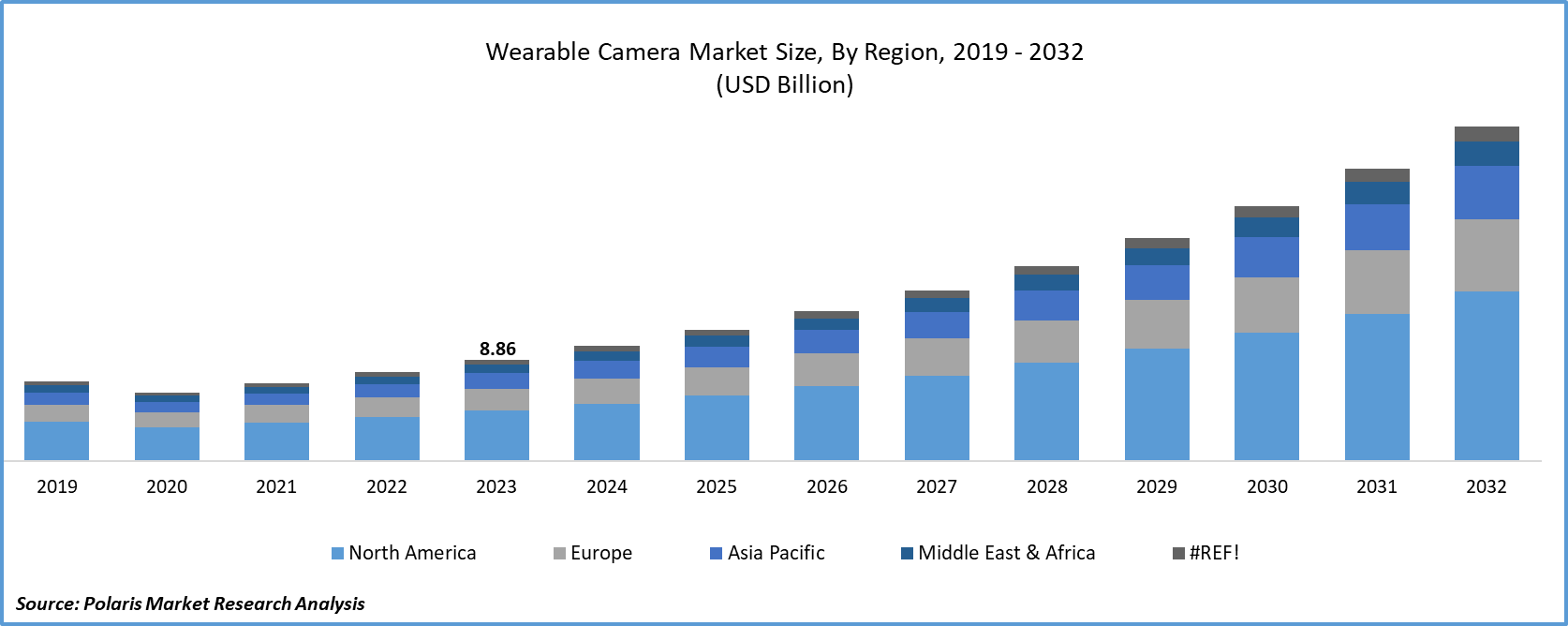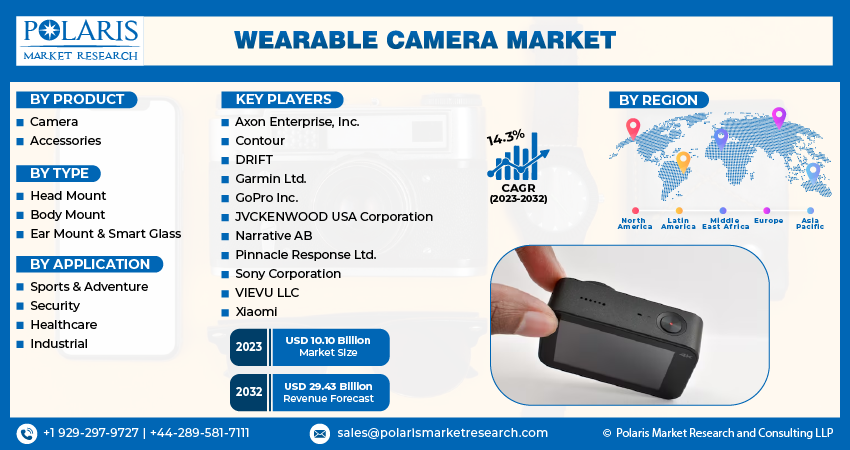
Wearable Camera Market Share, Size, Trends, Industry Analysis Report
By Product, By Application (Sports & Adventure, Security, Healthcare, Industrial), By Type, By Region, And Segment Forecasts, 2023 - 2032
- Published Date:Dec-2023
- Pages: 117
- Format: PDF
- Report ID: PM4134
- Base Year: 2022
- Historical Data: 2019-2021
Report Outlook
The global wearable camera market was valued at USD 8.86 billion in 2023 and is expected to grow at a CAGR of 14.3% during the forecast period.
Wearable cameras, often mounted on clothing, helmets, or accessories, allow users to capture photos and videos without the need to hold a camera. This hands-free operation is particularly valuable in various activities such as sports, outdoor adventures, and professional applications like law enforcement and security. Users can document their experiences and perform tasks without being encumbered by holding a camera, enhancing their overall efficiency and ease of use.

To Understand More About this Research: Request a Free Sample Report
The increasing trend of sharing experiences through photos and videos on social media platforms has created a substantial wearable camera market growth opportunity for wearable cameras. These devices offer improved low-light performance and enable users to capture high-quality videos with advanced image stabilization features. Further, the widespread availability of high-speed internet and the widespread use of various social media platforms and applications have incentivized users to embrace wearable camera technology, consequently fueling market expansion. The key factors contributing to the growth of this technology include convenience, responsiveness, and enhanced security.
Additionally, wearable cameras offer an exceptional user experience. They provide a unique perspective by capturing moments from the wearer's point of view, creating immersive and engaging content. This perspective is valuable in activities like extreme sports, travel, and first-person documentaries, where viewers can experience events as if they were directly participating. The immersive experience offered by wearable cameras enhances storytelling and content creation, making them popular among content creators, adventurers, and enthusiasts alike.
In the realm of security, wearable cameras are utilized by law enforcement officers, security personnel, and first responders. These devices enhance situational awareness, improve accountability, and serve as valuable evidence-gathering tools. Wearable cameras provide a direct perspective of the wearer's surroundings, aiding in monitoring and documentation during critical situations.

For Specific Research Requirements: Request for Customized Report
Consumer electronics have seen a surge in wearable camera adoption due to the popularity of vlogging, social media content creation, and live streaming. These devices enable users to create engaging and immersive content for their online audiences. Wearable cameras provide a unique point of view, adding depth and excitement to the content. In enterprise and industrial settings, wearable cameras are used for remote assistance, field inspections, and hands-free documentation. Workers can capture and share real-time information with experts or colleagues, improving communication and problem-solving capabilities.
Growth Drivers
- Continuous advancements in camera technology
The increasing trend of wearable technology and the integration of advanced features like high-resolution imaging, stabilization technologies, and connectivity options further enhance the appeal of wearable cameras. As technology continues to improve, these devices are becoming more sophisticated, reliable, and user-friendly, catering to a broader audience.
These devices have undergone substantial advancements, incorporating impressive features that allow users to record their experiences from a unique and first-person perspective. These features include high-resolution imaging capabilities, stabilization technologies, wide-angle lenses, and waterproof designs, making them suitable for capturing action-packed moments in sports and adventure activities. Users can document their experiences hands-free, providing an immersive view of their activities.
Report Segmentation
The market is primarily segmented based on product, type, application, and region.
|
By Product |
By Type |
By Application |
By Region |
|
|
|
|
To Understand the Scope of this Report: Speak to Analyst
By Product Analysis
- Camera segment held the largest share in 2022
Camera segment dominated the market. Segment’s growth is due to the operational efficiencies associated with wearable camera devices, such as integrated GPS and enhanced video stabilization features. Wearable cameras are valued for their ability to capture life experiences, offering an enhanced user experience, which is expected to drive product demand. Additionally, the rising demand for seamless connectivity between devices for online data sharing and cloud storage has further contributed to the growth.
Accessories segment will grow at significant pace. Accessories play a vital role in enhancing the functionality of wearable cameras by offering additional features. These accessories, such as mounts, straps, grips, and stabilizers, enhance the user experience, enabling more versatile and stable footage capture.
By Application Analysis
- Healthcare segment accounted for the largest market share in 2022
Healthcare segment accounted for the largest market share. Wearable cameras find applications in various fields, including surgeries, where they can record procedures from the surgeon's viewpoint. This recorded footage holds immense value for surgical training, education, and research purposes. Medical professionals such as students, residents, and surgeons can review and analyze these recordings to enhance their skills, refine techniques, and gain insights from real-life cases.
The rising consumer demand to monitor fitness levels and digitize medical records has boosted the medical cameras. For instance, these cameras equipped with advanced software & hardware can assess nutrition details and classify food items using image processing techniques. These innovative features are anticipated to have a positive impact on the industry.
By Type Analysis
- Head mount segment accounted for the largest market share in 2022
Head mount segment accounted for the largest market share. Head mounts provide a hands-free experience, enabling users to capture moments and record videos without the need to hold a camera. This feature is particularly appealing for sports, outdoor adventures, and vlogging activities, allowing users to engage in other tasks while recording.
Body mount segment will grow rapidly. Body-mounted cameras are gaining traction in security contexts. For instance, law enforcement agencies use body-worn cameras to document interactions with the public, collect video evidence at crime scenes, and record assaults or offenses. Growing consumer awareness about wearable camera advancements is also expected to boost market expansion.
Regional Insights
- North America region accounted for the largest share of global market in 2022
North America held the largest share. This dominance is attributed to the presence of established manufacturers and a sizable consumer base in the region. Region is renowned for its outdoor pursuits and adventure sports culture. Wearable cameras like action cameras and body-worn devices offer a hands-free solution for capturing and sharing experiences in activities such as skiing, snowboarding, mountain biking, and surfing. The popularity of these sports and the inclination to document and share thrilling moments contribute significantly to the demand for wearable cameras.
Asia pacific will grow at the substantial pace. This growth is attributed to the region's increasing disposable income, and macroeconomic stimulus measures. The demand for wearable cameras in the region is driven by innovative technologies and the rising trend of leisure spending, fostering the growth of the industry in this region.
Key Market Players & Competitive Insights
Major players are actively engaging in strategic efforts such as developing new products to create opportunities for enhanced profitability and stronger customer connections.
Some of the major players operating in the global market include:
- Axon Enterprise, Inc.
- Contour
- DRIFT
- Garmin Ltd.
- GoPro Inc.
- JVCKENWOOD USA Corporation
- Narrative AB
- Pinnacle Response Ltd.
- Sony Corporation
- VIEVU LLC
- Xiaomi
Recent Developments
- In June 2023, Realme, revealed its plans to introduce its camera flagship for 2023. The standout feature of this upcoming device is its remarkable 200-megapixel camera, marking a significant advancement in smartphone camera technology.
- In June 2023, Insta360 has revealed its plans to release a groundbreaking new camera, teasing that this upcoming product will be notably compact. Despite its small size, the camera promises to capture precious moments from distinct perspectives, including those of family members, friends, and even pets.
- In October 2022, Axis Communications has unveiled the AXIS W101, a body camera tailored for diverse sectors & markets. It offers improved audio & image quality, ensuring sharp images in each frame while efficiently reducing background noise.
Wearable Camera Market Report Scope
|
Report Attributes |
Details |
|
Market size value in 2024 |
USD 10.10 billion |
|
Revenue forecast in 2032 |
USD 29.43 billion |
|
CAGR |
14.3% from 2024 – 2032 |
|
Base year |
2023 |
|
Historical data |
2019 – 2022 |
|
Forecast period |
2024 – 2032 |
|
Quantitative units |
Revenue in USD billion and CAGR from 2024 to 2032 |
|
Segments covered |
By Product, By Type, By Application, By Region |
|
Regional scope |
North America, Europe, Asia Pacific, Latin America, Middle East & Africa |
|
Customization |
Report customization as per your requirements with respect to countries, region, and segmentation. |
FAQ's
key companies in wearable camera market Axon Enterprise, Contour, DRIFT, Garmin, GoPro, JVCKENWOOD, Narrative, Pinnacle Response
The global wearable camera market is expected to grow at a CAGR of 14.3% during the forecast period.
The wearable camera market report covering key segments are product, type, application, and region.
key driving factors in wearable camera market are Continuous advancements in camera technology
The global wearable camera market size is expected to reach USD 29.43 billion by 2032
